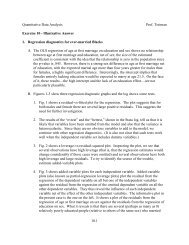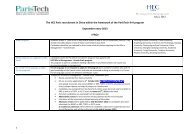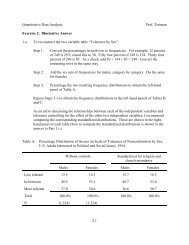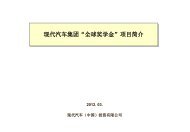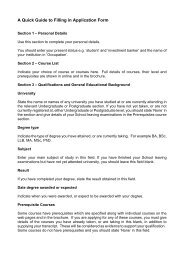Methods of Data Collection and Mode of Administration
Methods of Data Collection and Mode of Administration
Methods of Data Collection and Mode of Administration
You also want an ePaper? Increase the reach of your titles
YUMPU automatically turns print PDFs into web optimized ePapers that Google loves.
Introduction<strong>Methods</strong> <strong>of</strong> <strong>Data</strong> <strong>Collection</strong> <strong>and</strong><strong>Mode</strong> <strong>of</strong> <strong>Administration</strong>• Introduction: Defining method or mode <strong>of</strong> data collection*• Choice <strong>of</strong> mode*• Comparisons across modes• Effects <strong>of</strong> mode• Advantages <strong>and</strong> disadvantages <strong>of</strong> modes**These sections based on JPSM materialsThe evolution <strong>of</strong> survey technology*<strong>Methods</strong> <strong>of</strong> data collection <strong>and</strong> modes <strong>of</strong>administrationPaperMailTelephoneFTFComputerOCR/ICR FAXCSAQ <strong>Methods</strong>Disk-by-mail E-mail WebCATI TDE IVR/T-ACASICAPI CAI <strong>Methods</strong>• For the first several decades <strong>of</strong> survey research, “mode” meant one <strong>of</strong> thefollowing• Face-to-face or personal visit survey• Telephone survey• Mail survey• More ways <strong>of</strong> collecting data are now available <strong>and</strong> they are combined inmany ways• Now we need to distinguish among the different tasks that technology(including paper, telephones, mail) performs in our surveysSAQText-CASIAudio-CASIVideo-CASIWalkman8
Definition• Method <strong>of</strong> data collection or mode <strong>of</strong> administration sometimes refer to• Method for contacting sample member• In-person, telephone, mail, internet• Means by which question is administered to respondent• Interviewer, other aural, text• Medium on which response is recorded• Paper, computer• Method <strong>and</strong> mode are also closely associated with sample framePrincipal modes <strong>of</strong> administering questions <strong>and</strong>recording responsesQuestion<strong>Administration</strong>Interviewer(IAQ)Interviewer(IAQ)Voice <strong>and</strong>textFace-t<strong>of</strong>aceRecordingResponsesPaperPAPITelephone PATIComputer(CAI,CASIC)CAPICATIA-CASIText SAQ CASIP Mixed mode surveys may combine more than one means <strong>of</strong> delivery or morethan one means <strong>of</strong> question administration or responseP Other modes – TDE, direct to disk, web-based surveys, etc. – have beenstudied less.Computer-assisted survey information collection(CASIC) or Computer-assisted interviewing (CAI)• Technologies that are available change rapidly• Task performed by technology include• Manage sample• Present survey questions• Record answers• Edit data• Exchange dataImplications <strong>of</strong> the proliferation <strong>of</strong> methods <strong>and</strong>modes• Need to ask what reference to mode refers to <strong>and</strong> to be explicit in yourown work• Research about method or mode effects• Need to be explicit about what “mode effect” refers to (e.g., frame,method <strong>of</strong> contact, method <strong>of</strong> administration)• Literature does not (yet) cover all variations• Need theory to inform expectations about effects• Mixed-mode surveys or hybrid designs• Increasingly common• Effect <strong>of</strong> mode may depend on the particular combination <strong>of</strong> methodsused• Designs to test effects increasingly difficult to design <strong>and</strong> interpret• Hard to generalize about mode comparisons
Choosing method <strong>of</strong> data collection:Considerations• Survey population: Characteristics, abilities, resources, <strong>and</strong>interests• Sample frame: Information available in sample frame (area,name, address, telephone number)• Sample design: Clustering, stratification, selection <strong>of</strong> respondent• Study topic: Sensitivity, task difficulty, need to use visual aids• Analytic goals: Comparisons needed with studies using othermodes• Interviewer corps: Ability <strong>and</strong> experience• Response rate: Need for high response rate• Administrative infrastructure: Availability <strong>of</strong> technology <strong>and</strong>experience with technology• Cost: Desired length <strong>of</strong> field period• Cost: Other considerationsChoosing method <strong>of</strong> data collection (continued)• Impact <strong>of</strong> mode on error• Sampling error• Coverage error• Nonresponse error• Measurement error• Comments:• Decisions about error require consideration <strong>of</strong> time <strong>and</strong> budgetconstraints <strong>and</strong> trade-<strong>of</strong>fs• There is no one best mode for all situationsChoice <strong>of</strong> mode: Frame• Three basic types <strong>of</strong> frames: area, telephone, <strong>and</strong> list• Area frame: no list <strong>of</strong> addresses or persons in U.S., so usegeographic/political units as frame• Telephone: Most designs now are list-assisted RDD, <strong>and</strong> increasinglyhave dual-frame designs with cell phones• Mail: Addressed-based sampling (ABS) provide frame for mail surveys<strong>of</strong> household• List: lists vary in the amount <strong>and</strong> quality <strong>of</strong> information in the frame<strong>and</strong> what modes they can support• Information in frame <strong>and</strong> survey design• Frames vary in coverage <strong>of</strong> target population• Information in frame determines how sample unit can be contacted<strong>and</strong> how survey instruments can be distributed• If frame includes address, design can include advance letters,prepaid incentives, etc., regardless <strong>of</strong> mode• Some frames provide ability to subsample within sample clusters onthe frame (e.g., within households)• Frames vary in coverage <strong>of</strong> target populationChoice <strong>of</strong> mode: Coverage <strong>and</strong> other problems insampling frames• Typical frames differ in how well they cover target population• Frames may provide information for assessing or determining eligibility<strong>of</strong> units on the frame (e.g., administrative record in frame based onobservation <strong>of</strong> or self-report from sample unit)• All designs that involve selecting respondents share coverage errors dueto measurement errors made by respondent (e.g., for number <strong>of</strong>persons in household, last birthday, etc.)
Choice <strong>of</strong> mode: Coverage <strong>and</strong> other problems insampling frames• Area probability frames• In principle could include all, in practice include those in sampling units(e.g., households)• Coverage error due to listing errors by interviewers• Coverage errors may be reduced by use <strong>of</strong> address lists• List-assisted telephone frames (RDD)• Exclude those without telephones• Exclude with only cell phones unless use a dual-frame design• Those with only cell phones more likely to be young, poor, <strong>and</strong>renters• Duplicates both within <strong>and</strong> across l<strong>and</strong>line <strong>and</strong> cell phone frames• Address-based samples• Potentially excellent coverage• Quality may be poorer in rural areas or areas with delivery to mailboxestnrceeP70.060.050.040.030.020.010.00.0US Households withComputer <strong>and</strong> Internet Access (CPS)..1984..1989 ..1993..1997 ..2000..2001 ..2003..2007ComputerInternetU.S. Households with Computers, by Income*1009080706050403020100All
Comparison <strong>of</strong> address-based sampling (ABS)<strong>and</strong> RDD (Link et al. 2008)Choice <strong>of</strong> <strong>Mode</strong>: Sampling error• Clustering• Increases sampling variance, but reduces costs• Less clustering is needed in telephone than face-to-face surveys• Maximum dispersion possible in self-administered methods based onlist (address) sample• Sample size• Cheaper modes make larger sample size possible for a given budget• XMethod <strong>of</strong> data collection: Nonresponse• <strong>Methods</strong> vary in• Rates <strong>of</strong> nonresponse• Sources <strong>of</strong> nonresponse• Types <strong>of</strong> nonresponse• Noncontact: Access restrictions vary by method• Telephone: Caller-ID, answering machines• Face-to-face: Gated communities, locked apartment buildings• Mail: Difficult to distinguish ineligible, non-contact, <strong>and</strong> refusals• Web: Access to web <strong>and</strong> spam filters• Refusals: Willingness to cooperate may depend on method <strong>of</strong> contact• Mail: Limited to written materials <strong>and</strong> incentives• Interviewers: Potential ability to tailor responses to respondent’sconcerns• Respondents vary in ability to use different methods• Mail <strong>and</strong> self-administered: Literacy• Computer-assisted: Comfort with technology• Web: Access to webNonresponse: Mail• Rogers (1989):• average <strong>of</strong> 20.2 pieces <strong>of</strong> mail received per week• 42% increase in mail received over 10 years• 200% increase in 3rd class mail• Mathiowetz, Couper <strong>and</strong> Singer (1994):• systematic variation in amount <strong>of</strong> mail received by income, urbanicity,race• in 63% <strong>of</strong> households, 1 person responsible for opening mail• 63% <strong>of</strong> households throw some mail away without opening• modest association with census mail return, controlling on other factors
Nonresponse: MailNational Assessment <strong>of</strong> Adult Literacy (2003)• Conducted in 2003, over 19,000 adults participated in the national <strong>and</strong>state-level assessments, representing the entire population <strong>of</strong> U.S. adultswho are age 16 <strong>and</strong> older, most in their homes <strong>and</strong> some in prisons fromthe 50 states <strong>and</strong> the District <strong>of</strong> Columbia. (http://nces.ed.gov/naal/)Choice <strong>of</strong> mode: Measurement process• How data collector or interviewer is involved• Interviewer administers questions• Interviewer present during self-administration• Self-administration without interviewer present• The type <strong>of</strong> contact between interviewer <strong>and</strong> respondent• Co-present, physical <strong>and</strong> social: face-to-face• Co-present, social: telephone• Indirect presence: mail or web• None: direct observation, administrative recordsChoice <strong>of</strong> mode: Measurement process(continued)• Channels <strong>of</strong> communication used to present questions• Aural only (example:Telephone survey with no visual aids)• Aural + visual (example: Face-to-face with show cards )• Visual only (example: Mail SAQ, CASI)• Visual on a screen may differ from visual on paper• Visual can include only text or text <strong>and</strong> pictures• Type <strong>of</strong> technology used to record answer• Paper: mail, paper-based methods• Electronic technology:• <strong>Data</strong> collector: computer-assisted interviewing• Respondent uses electronic technology supplied by surveyorganization: computer-assisted self-interviewing• Respondent uses own electronic technology: Web surveys
Choice <strong>of</strong> mode: Measurement process(continued)• Privacy, presence <strong>of</strong> others• Low privacy: exit interviews, intercept surveys, group administeredsurveys• Medium privacy: in-home interviewer-administered surveys• Medium high privacy: telephone• High privacy: laboratory-based measurementMeasurement process: Classification <strong>of</strong> modes<strong>of</strong> administration (Biemer <strong>and</strong> Lyberg 2003, Table6.1)High <strong>Data</strong> CollectorInvolvementPaperComputerLow <strong>Data</strong> CollectorInvolvementPaperComputerDirect RcontactIndirect RcontactNo RcontactFace toFace (PAPI)Telephone(PAPI)DirectObservationFace-to-Face (CAPI)CATICADEFace to face(Diary)Mail, fax,emailAdministrativeRecordsFace toFace (CASI,ACASI)TDE, email,Web, DBM,EMS, VREEDI7<strong>Mode</strong>: MeasurementMeasurement: Respondent• <strong>Mode</strong> affects all aspects <strong>of</strong> measurement process• Interviewer• Respondent• Instrument• Respondents vary in• Preference for mode• Motivation <strong>and</strong> ability to perform in different modes• Tendency to satisfice, acquiesce, give socially desirable answers• <strong>Mode</strong>s vary in ability to provide respondents assistance with difficultresponse tasks
Measurement: Interviewer• Advantages <strong>and</strong> disadvantages <strong>of</strong> presence <strong>of</strong> interviewer• Presence <strong>of</strong> interviewer enables use <strong>of</strong> more complex instruments <strong>and</strong>mixed modes (e.g., audio-CASI)• Presence <strong>of</strong> interviewer may increase roh_int• Advantages <strong>of</strong> centralized telephone interviewing (compared todecentralized telephone or face-to-face)• Increases st<strong>and</strong>ardization <strong>and</strong> therefore reduces roh_int• Training is cheaper, can be more intensive, <strong>and</strong> be ongoing• Continuous supervision <strong>and</strong> monitoring are possible• Greater flexibility in assignment <strong>of</strong> cases• Disadvantage <strong>of</strong> centralized telephone interviewing• Without travel burden, telephone interviewers can have largerworkloads, which may lead to larger impact <strong>of</strong> rho_intMeasurement: Instrument• Length <strong>of</strong> questionnaire• Complexity <strong>of</strong> instrument• Skip patterns, branching, instructions• Alternative measurement tools <strong>and</strong> visual aids: showcards,observation, direct measures, etc.• Error checks, range checks• Question form• Open questions• Number <strong>of</strong> response alternatives• Effects on answers• Item nonresponse• Social desirability• Effects <strong>of</strong> response order• Primacy <strong>and</strong> recency• Effects <strong>of</strong> question order• Assimilation <strong>and</strong> contrastPaper vs computer• <strong>Data</strong> Quality• Little effect on unit nonresponse, item nonresponse• Timeliness• Effects on production schedule• Complexity <strong>of</strong> the survey instrument• Computer-assisted interviews can include dependentinterviewing, complex fills, complex skips• Computer-assisted instruments produce meta-data (such astiming) at little additional cost• Difficult to compare costs• Computer-assisted instruments are <strong>of</strong>ten more complex thanpaper• Testing <strong>and</strong> debugging• Project management may be more complex for CAIEffect <strong>of</strong> dependent interviewing on longitudinaldata• Substantial proportion <strong>of</strong> monthly industry <strong>and</strong> occupation changes inCPS found to be spurious (Collins, 1975)• 39% <strong>of</strong> those reporting no job change have different occupation code insuccessive months• 21% <strong>of</strong> those reporting no change in employer had different industrycodes• CATI/RDD test using dependent interviewing (Dippo et al., 1994)• 7% changed occupation code from month to month• 5% changed industry code from month to month
Choice <strong>of</strong> mode: Costs• Staff• Centralized telephone staff compared to field staff• Can be deployed on different studies• Fewer are needed, so hiring <strong>and</strong> initial training is moreeconomical• Can be trained <strong>and</strong> supervised more economically• Mail surveys have less complex staffing needs• Nonresponse followup: Cost <strong>of</strong> repeated contacts varies by mode• Field period: <strong>Methods</strong> differ in how quickly get into <strong>and</strong> out <strong>of</strong>field• Infrastructure: Computer-assisted methods require equipment,frequent updating, <strong>and</strong> trained staffFive different types <strong>of</strong> mixed-mode design (Groves et al.2004, p. 163; Dillman <strong>and</strong> Tarnai, 1988)• One mode for some Rs, another mode for others• e.g., telephone survey, with FTF component for those without telephones• e.g., mail survey with web response option• One mode for recruitment, another for survey administration• e.g., mail invitation for web survey• e.g., telephone recruitment for IVR survey• One mode for data collection, another for reminders or follow-up• e.g., telephone reminders for mail or web survey• One mode for one wave <strong>of</strong> a panel survey, another for others• e.g., first wave <strong>of</strong> panel is FTF, subsequent waves by telephone or mail• One mode for main part <strong>of</strong> the interview, another mode for some subset <strong>of</strong> items• e.g., audio-CASI for sensitive items• One mode for one sample frame, another mode for another sample frame; bothframes for the same population• e.g., dual-frame RDD <strong>and</strong> area probability design• Use one mode for one population <strong>and</strong> another for another population, with goal<strong>of</strong> comparing them• telephone for elites, mail for nonelitesComparisons across modes:Design factors affecting mode comparisonsSampling Frame definition <strong>and</strong> coverageSample designRespondent selection rules <strong>and</strong>proceduresNonobservation Procedures to gain initial cooperationFollowup for noncontactRefusal conversionItem nonresponseMeasurement Question technique <strong>and</strong> instrumentdesignRecording medium - paper vs computerInterviewing Experience <strong>of</strong> staffTrainingSupervision <strong>and</strong> quality controlAssignment sizeComparisons across modes: Two extremes• Hold all features <strong>of</strong> design constant <strong>and</strong> vary only means <strong>of</strong> delivery ormeans <strong>of</strong> question administration <strong>and</strong> response• Compare "typical" designs for each mode
<strong>Mode</strong> comparisons: Strategies• Panel design with second wave assigned to different modes• Use <strong>of</strong> frame with information for both modes (e.g., telephone directory,register)• Use <strong>of</strong> different frames for each mode (e.g., area sample <strong>and</strong> RDDsample)• Meta-analysis <strong>of</strong> mode comparison studiesComparisons across modes: Examples• Panel designs• Use "maximum" <strong>of</strong> one mode (e.g. face- to-face) at time 1 <strong>and</strong> <strong>of</strong>another mode (e.g., telephone) at time 2.• R<strong>and</strong>om halves <strong>of</strong> sample assigned to different modes at time 2.• Split sample designs• Address or area frame. Obtain telephone numbers. Assign half topersonal <strong>and</strong> half to telephone.• Area frame for face-to-face interviews. Independent sample fromtelephone exchanges for telephone.Mail vs face-to-face surveys (Krysan, Schuman, Scott <strong>and</strong>Beatty 1994)Face-to-FaceMail1992 DAS 1992 DASArea probability,oversample from stratumwith high proportion blackAdult r<strong>and</strong>omly selected byinterviewersOne hour interview(220-300 questions)Pen in advance as giftAddresses selected fromDAS frame, but nooversample frompredominantly blackstratumAdult with most recentbirthdayApproximately 10 minutequestionnaire$1 with questionnaireResponse rates by mode <strong>of</strong> administration <strong>and</strong> racialcomposition <strong>of</strong> the strata (Krysan et al. 1994, Table 1)Predominantly WhiteStratumMail(a)Face-to-face(b)Predominantly BlackStratumMail(c)Face-to-face(d)Response rate 74 75 46 83N 476 1,037 84 512Significant comparisons: d vs c, a vs c, b vs cP Results for predominantly black stratum confound race,education, income, <strong>and</strong> urban residence.P In calculating response rates for mail survey,nonrespondents include addresses with no completedquex or for which postal service did not return the quex asundeliverable
Sample <strong>and</strong> nonsample addresses by mode <strong>of</strong>administration <strong>and</strong> racial composition <strong>of</strong> the strata(Krysan et al 1994, Table 2)PredominantlyWhite StratumMail(a)Face-to-face(b)PredominantlyBlack StratumMail(c)Face-to-face(d)Sample addresses 94 96 88 89Nonsample addresses 6 4 12 11Vacant houses 3 4 6 10No eligible respondent ...
Effects <strong>of</strong> mode: Participation• Sample frame <strong>and</strong> design• information about sample unit• method for selecting respondent• screening• Initial approach• advance letter• show <strong>of</strong> credentials• demonstration <strong>of</strong> "harmless" presence, legitimacy• Followup• mode <strong>and</strong> staffing <strong>of</strong> followup contacts• availability <strong>of</strong> mixed mode contacts• Respondent preference• Comment: <strong>Mode</strong>s differ in which interpersonal norms are activated <strong>and</strong>provide motivation for participation. <strong>Mode</strong> may affect who participates aswell as how many participateEffect <strong>of</strong> mode on participation: Comparison <strong>of</strong>face-to-face <strong>and</strong> telephonePercent CompleteFaceto-faceTelephoneHochstim (1967:979) 93 91Groves( 1979: 192) 74 59-70Jordan et al. (1980: 212) 64 49Sykes <strong>and</strong> Collins (1988) 606867de Leeuw & van derZouwen (1988:288)53464575 69Effect <strong>of</strong> mode on participation: Metaanalysis<strong>of</strong> 45 studies (Hox <strong>and</strong> de Leeuw1994)P face-to-face 70%P telephone 67%P mail 61%Effects <strong>of</strong> mode: Item nonresponseStudy Question FTF vs PhoneGroves <strong>and</strong>Kahn(1979:195)Jordan et al.(1980:212-16)Kormendi(1988:347)de Leeuw <strong>and</strong>van derZouwen (1988)Sykes <strong>and</strong>C o llin s(1988:311)incom eincom eattitudesincom evariousalcoholm ore m issingphonemore missingphonemore DK/NAphonem ore m issingphoneslightly m ore likelyto be missing onphonem ore likely to bemissing inpersonal
Effect <strong>of</strong> mode: Comments about itemnonresponse• Differences in item nonresponse by mode appear to decline over time asorganizations get experience with telephone surveys• Some differences due to variation in question design• Item nonresponse is probably further reduced with computer-assistedmethods which are increasingly availableEffect <strong>of</strong> mode: MeasurementAnswers to survey questions - Parallel open questionsStudy Topic FTF vs telephoneGroves(1978:260)Jordan et al.(1980:217-218)*Sykes <strong>and</strong>Collins(1988:307,314)Problems facingthe countryreasons for notseeing an MDN acuteconditionsN chronicconditionsN currentprescriptionsattitudesexplanationsMore mentions inpersonalno differenceno differenceno differenceno differencemore mentions inpersonalmore mentions ontelephoneEffect <strong>of</strong> mode may be greater for open questions aboutattitude objectsEffect <strong>of</strong> mode: MeasurementAnswers to survey questions - Cards <strong>and</strong>checklists (Jordan et al. 1980:218)Effect <strong>of</strong> mode: MeasurementAnswers to survey questions - Response patterns(Groves 1979:200-201)Number <strong>of</strong> ItemsMentionedPhone PersonalVoluntary preventive health 1.4 1.0behaviorKinds <strong>of</strong> family advice 1.3 .9Kinds <strong>of</strong> advice from friends 1.1 .61Personal uses card, telephone uses checklistAll differences significantPercent choosing same answer Phone Personal3 or more times over 5 itemsDelighted-terrible (unfolded) 59 53Dissatisfied-satisfied(numeric partially-labeled)58 55Percent choosing specificcategories 3 or more timesover 5 itemsPhonePersonalDelighted-terribleMixed 8 2Mostly satisfied 14 13Pleased 18 23Delighted 20 14There may be aslightly greatertendency to usethe samecategoryrepeatedly inphone vs face-t<strong>of</strong>ace
Effect <strong>of</strong> mode: MeasurementAnswers to survey questions - Responsepatterns (Jordan et al. 1980:218)Mean Scores on ResponsePattern CountsPhone PersonalAgreement 13.9 12.5Evasiveness .6 .5Extremeness 2.5 1.9Effect <strong>of</strong> mode: MeasurementAnswers to survey questions - Social desirability• Lower visibility on telephone may lower pressure for desirable answers• Less intimacy, desire to conform• Fewer characteristics <strong>of</strong> interviewer can be seen as relevant• Lower visibility on telephone may increase perception <strong>of</strong> possible threat• Interviewer cannot display credentials• Status <strong>of</strong> interview as interview may remain ambiguousCompared to telephone interviews, answers to rating scaleswith "vague quantifiers" in self-administered instrumentsappear to be (review in Dillman <strong>and</strong> Tarnai 1988):less extremeshow fewer category order effectsEffect <strong>of</strong> mode: MeasurementAnswers to survey questions - Social desirability<strong>of</strong> face-to-face vs phoneTheory <strong>of</strong> mode effects for in-person data collection(Tourangeau <strong>and</strong> Smith 1998)Hochstim (1967)Loc<strong>and</strong>er et al.(1976)Sykes <strong>and</strong> Collins(1988:306)Sykes <strong>and</strong> Collins(1988: 312)de Leeuw <strong>and</strong> v<strong>and</strong>er Zouwen (1988)apparent ranking:personal,telephone, mailsimilar to eachotherpattern <strong>of</strong> more SDin personal ingeneral surveymore SD inpersonal for Qsabout alcoholSD lower inpersonal
<strong>Mode</strong> Effects <strong>and</strong> Reports <strong>of</strong> Illicit Drug Use: Proportions <strong>of</strong> RespondentsReporting Drug Use Relative to SAQ (Tourangeau <strong>and</strong> Smith 1998, Table 22.1)<strong>Mode</strong> Effects <strong>and</strong> Reports <strong>of</strong> Illicit Drug Use: Proportions <strong>of</strong>Respondents Reporting Drug Use Relative to SAQ (Tourangeau <strong>and</strong>Smith 1998, Table 22.1)Time FrameStudy Year <strong>Mode</strong> vs <strong>Mode</strong> Drug PastMonthPastYearLifetimeAquilino (1994) In-person SAQ Cocaine 0.67 0.75 0.88Marijuana 0.83 .0.77 0.98Telephone SAQ Cocaine 1.00 1.00 0.76Marijuana 0.67 0.62 0.96Aquilino<strong>and</strong>LoSciutoGfroerer<strong>and</strong>HughesSchober etal.Turner,Lessler,<strong>and</strong>Devore(1990) Telephone SAQ – Cocaine 0.83 0.85 1.10WhitesMarijuana 1.00 0.96 1.00Telephone SAQ – Cocaine 0.60 0.82 0.82BlacksMarijuana 0.41 0.72 0.80(1992) Telephone SAQ Cocaine 0.49 0.70Marijuana 0.65 0.75(1992) In-person SAQ Cocaine 0.60 0.75 0.89Marijuana 0.75 0.83 0.99(1992) In-person SAQ Cocaine 0.42 0.68 0.94Marijuana 0.62 0.77 0.95• In Aquilino’s study, ratio<strong>of</strong> proportion <strong>of</strong> Rsreporting cocaine use byphone to proportion <strong>of</strong> Rsreporting by SAQ is .67• Ratios under 1 indicatelower reporting in modeother than SAQ• No ratio is greater than 1• Ratios tend to besmallest for most recenttime frame <strong>and</strong> closer to1 for lifetimeMean number <strong>of</strong> adult lifetime sex partners reported bymen <strong>and</strong> women, 1989 GSS (Smith 1992, Table 7)Males Females Males:FemalesUnadjusted 13.00 3.24 4.06:1Adjusted for 12.05 3.03 3.98:1nonresponseAdjusted forextreme values9.36 3.02 3.10:1• In a closed population, reports <strong>of</strong> men <strong>and</strong> women should yield the sameestimates <strong>of</strong> number <strong>of</strong> sexual partners.• Estimates based on men's reports are higher than estimates based onwomen's reports.• Results suggest that techniques that decrease men's reports or increasewomen's reports improve reporting.Mean reported sex partners by mode <strong>of</strong> interview (ACASIExperiment, Tourangeau <strong>and</strong> Smith 1996, Table 3)<strong>Mode</strong>PastYearPast 5YearsLifetimeACASI 2.26 4.52 7.05CASI 1.87 2.99 5.75CAPI 2.14 3.44 5.51• Effect <strong>of</strong> mode is significant for lifetime reports <strong>and</strong> marginally significantfor 5-year reports.• ACASI yields higher reports than CASI for lifetime <strong>and</strong> 5-year reports.• Cell sizes range from 86 to 104. Significance tests based on logged data.Typology <strong>of</strong> Web SurveysWeb surveys withgeneral invitationsNo0. Entertainment polls1. Unrestricted self-selectedsurveysNon-probability surveysProbability-based surveysNo2: Volunteer opt-in panels?: Surveys <strong>of</strong> spam listsList <strong>of</strong> participants invitedto the survey?Yes, prior to datacollectionWeb surveys withindividual invitationsProbability sample?YesYes, generated duringdata collectionIntercept surveys3. Pop-up surveys3. Selective banner ads4: List-based samples5: Web option in mixed-mode surveys6: Pre-recruited lists <strong>of</strong> Internet users7: Pre-recruited panels <strong>of</strong> full populationSource: based on Lozar Manfreda’s (2001) revision <strong>of</strong> Couper (2001)48
Web-based surveys: Considerations• Security• Server capacity• Additional layer <strong>of</strong> testing related to usability• Variable platform environment• Questionnaire design• Usability• Graphics, video streamOther modes: Diary surveys• Major uses: expenditures, time use, nutrition• Advantages• Avoid recall errors• Obtain detailed information• Reduce proxy reporting, social desirability effects• Reduce costs, relative to face to face interview• Disadvantages:• Declining interest, reporting over time• Underreporting• Change <strong>of</strong> behavior• Structure <strong>and</strong> complexity <strong>of</strong> diary• Problems <strong>of</strong> late placement <strong>and</strong> recall periodOther modes: Administrative recordsOther modes: Direct observation• Major uses: income data (tax forms), hospital data• Advantages:• Relatively cheap (data already exist)• Low (no) additional respondent burden• May augment survey data• May provide opportunities for validity studies• Disadvantages:• Limited to data available on records• Quality <strong>and</strong> timeliness <strong>of</strong> information on records• Coverage problems• Informed consent, confidentiality issues• Examples <strong>of</strong> measurements by visual inspection• Condition <strong>of</strong> housing unit or neighborhood• Display <strong>of</strong> books, furniture in home• Interaction among household members• Physical condition <strong>of</strong> respondent• Can be unobtrusive or obtrusive• Generally requires more careful interviewer training because <strong>of</strong> lack <strong>of</strong>structure <strong>of</strong> visual observation• Little is known about interviewer variability for such measures
Summary: Advantages <strong>of</strong> face-to-face surveys• Face-to-face interviews are only possible if the address <strong>of</strong> the sample unit isavailable• Most compatible with area probability <strong>and</strong> list samples• Nonparticipation• Can contact respondents without telephones• Best for gaining cooperation (high response rate)• Physical presence <strong>of</strong> interviewer provides more information aboutinterviewer, which can aid in building trust• Physical presence provides interviewer more information about respondent,which can aid her in tailoring appeals for cooperation• Measurement• Advantages <strong>of</strong> interviewer administration• answer questions <strong>and</strong> provide clarification• probe• following skips• longer, more complex interviews possible• use <strong>of</strong> visual aids• Advantages <strong>of</strong> interviewer presence• Permits addition <strong>of</strong> self-administered portion• Permits other types <strong>of</strong> data collection (observation, visual cues)Summary: Disadvantages <strong>of</strong> face-to-face surveys• Staff <strong>and</strong> field costs• Need trained staff <strong>of</strong> geographically dispersed interviewers• Training <strong>and</strong> supervision more complicated• Workload must be maintained to retain staff• Requires longer field period to collect data than telephone method• These may need to higher cost than telephone• Nonparticipation• Some areas (high rise buildings, high crime areas) may be lessaccessible to personal interview• Measurement• Effect <strong>of</strong> interviewer• Interviewer bias (cheating, distortion, errors)• Physical presence provides respondent more information aboutinterviewer, which may increase impact <strong>of</strong> social presence orrapport on socially desirable answersSummary: Advantages <strong>of</strong> telephone surveys• Telephone interviews are only possible if the telephone number is available• Most compatible with RDD or list samples• Sampling error• Can reach geographically dispersed sample• List samples can be spread over a wide area• RDD samples have low clustering• Staff <strong>and</strong> field costs• No travel costs• Staff can be centralized, reducing costs <strong>of</strong> recruiting, training, supervising, <strong>and</strong> retaining• Field period may be shorter than FTF or mail• Leads to lower costs than FTF• Nonparticipation• Some units may be easier or safer to reach by telephone than personal visit• Restricted access or high crime areas are easier to reach by telephone• Measurement• Advantages <strong>of</strong> interviewer administration• answer questions <strong>and</strong> provide clarification• probe• following skips• longer, more complex interviews possible than self-administered on paper• Better interviewer training <strong>and</strong> supervision in centralized facility• Interviewer variance <strong>and</strong> bias reducedSummary: Disadvantages <strong>of</strong> telephone surveys• Frame: Coverage <strong>and</strong> eligibility• Those without phone or with only cell phone cannot be included• For RDD designs, this results in coverage problems• More difficult to identify ineligible, non-household numbers• Nonparticipation• For list designs, units without telephones cannot be contacted <strong>and</strong>become unit nonrespondents• Access problems (answering machines, caller-ID)• More limited methods <strong>of</strong> recruitment (e.g., may not always haveaddress)• Nonresponse typically higher than FTF• Measurement• Questionnaire constraints• Fewer response alternatives• No visual aids• No interviewer observations
Summary: Advantages <strong>of</strong> mail surveysSummary: Disadvantages <strong>of</strong> mail surveys• Mail surveys require an address• Most compatible with list samples with a named respondent• Staff <strong>and</strong> field costs• Relatively low cost• Minimal staff <strong>and</strong> facilities required• Sample• Provides access to widely dispersed sample• Design does not need to be clustered• Measurement• Respondents have time to give thoughtful answers, look up records, orconsult with others• Best for sensitive questions, avoidance <strong>of</strong> social desirability bias• Reduced response or question order effects• Frame• Need for good mailing address limits designs with which it can be used• Within-household selection <strong>of</strong> respondents difficult, so respondent mustusually be identified on frame• Nonparticipation• Relatively low response rates• Measurement• Disadvantages associated with lack <strong>of</strong> interviewer presence• Literacy requirement limits utility• Short, less complex questionnaires• Increased item missing data



